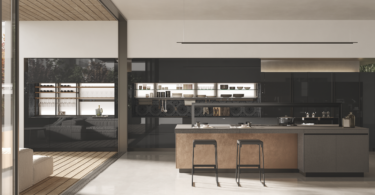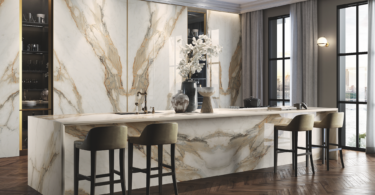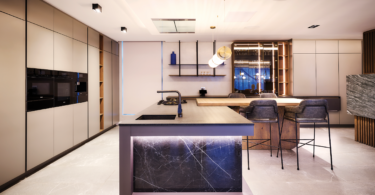The kitchen is one of the busiest (if not THE busiest) areas in the home. With its constant foot traffic and occasional spills, the floor can take quite a beating. That is why you need to do your homework when it comes to selecting a durable, comfortable and hard-wearing floor material.
Some factors to consider
• What kind of kitchen are you after? Do you want everything to look sleek, shiny and polished or would you prefer something with a few flaws and a more rustic character? The style of your kitchen will help guide you in terms of materials, colours and patterns.
• Do you have an open floor plan? If you do, a hardwood or laminate floor, for example, will work well to create warmth, encourage flow and unify your kitchen and other living spaces.
• What kind of budget are you working with? This will determine whether you can spend R360 per square metre on bamboo versus R1 690 for reclaimed, handcrafted rift wood.
• How much time do you have for cleaning and upkeep? Wanting to simply mop up and go will help cancel out your more porous options, for instance.
• Are you particularly eco-conscious? If you feel there is no justifiable reason to cut down a 50-year-old tree to turn into a floor, then cork and bamboo are two options that are sustainable.
A look at floor types…
Concrete
Concrete is great if you’re after a clean and contemporary look. It can take on different sheens, colours and patterns (for instance, it can be stained and scored to resemble large tiles). It can even be made to resemble kinds of stone. It’s a budget-friendly choice – although it does require periodic sealing. On the downside it’s a very hard floor, so it can take a toll on your joints if you spend long periods planted in front of the stove. One way to counter this is to lay mats or rugs in areas where you spend a lot of time standing.
Tiles
From shiny and glazed, to unglazed and matt, to polished porcelain, to ceramics with a wood-grain or natural-stone appearance, today’s tiles are available in an array of finishes. They are also hard, durable, stain-resistant and impervious to moisture. Just make sure that you buy ‘floor’ tiles. If you accidentally choose a wall tile for a floor, it could prove too slippery to walk on and crack or chip more easily. Always opt for a floor tile that has a slightly raised pattern or texture that is slip-resistant.
Hardwood
If you want to take your home to another level of elegance, then wooden floors are the way to go. Yes they are expensive, but they are unmatched if you want to create a look that never really goes out of style. Wooden floors will also give you a good return on investment if you ever sell your home. Wooden flooring is made in two ways – as solid wood strips or engineered wood planks. Engineered wood is the better choice for kitchens. It has a veneer of real wood backed by layers of less-expensive plywood. A wooden floor can withstand decades of use, is low-maintenance and perfect for open floor plans. Some drawbacks to wood are that it can gouge and scratch easily, plus solid woods are vulnerable to moisture.
Laminate and vinyl
Laminate flooring is a fast and easy way to create the warm and sophisticated look of wooden floors without breaking the bank, while vinyl flooring has come a long way over the years and is available in a wide range of colours and textures. Both are budget-friendly flooring options and are soft underfoot. They also tend to be more moisture resistant than hardwood floors. On the downside, because they are not solid all the way through, they can’t be refinished if damaged.
Bamboo
It may technically be a grass, but bamboo has many of the same advantages and disadvantages as wood. It’s a good option if you are looking to use an economical, low-maintenance, eco-friendly, sustainably-harvested and strong material (the strand-woven varieties are considered to be harder than oak, maple and many Brazilian hardwoods). Unlike laminate flooring, bamboo can be refinished at least five times during its lifetime (sanded and sealed) without having to worry about wearing down the thickness of the ‘wear layer’.
Cork
Cork flooring is quiet, durable and softer underfoot than hard tile or concrete. Like bamboo it is also sustainable as cork trees take just nine years to regenerate. It is naturally textured, which makes it slip-resistant, plus it has a unique cellular structure that’s waterproof and compressible. Also, every tile or plank has a unique grain pattern of swirls and speckles. It is somewhat ‘self-healing’ but it can get scratched and dented, so it’s a good idea to reseal it every three to four years.
Rubber
This may seem a bit of an unusual choice for a home kitchen, but rubber flooring is soft, springy and durable. It’s especially terrific if you want to stand for hours in your kitchen without bringing on aches and pains. It’s available in tile and sheet formats and should be sealed after installation and again every year or two, depending on foot traffic and wear.
Quick tip: It’s important to consider how wide the boards or how big the tiles will be when it comes to kitchen flooring. Think about how your kitchen units and appliances will sit on them – where the lines will fall. If the flooring lines aren’t parallel or perpendicular to the plinths, but rather sit at an angle, it won’t look right.











Leave a Comment